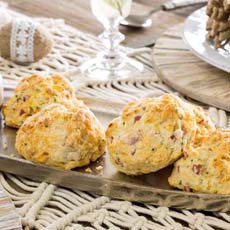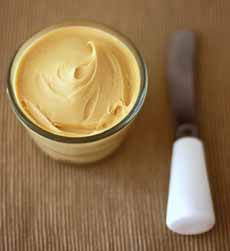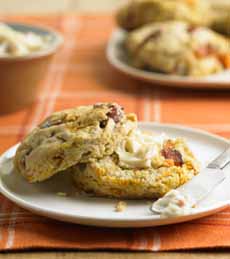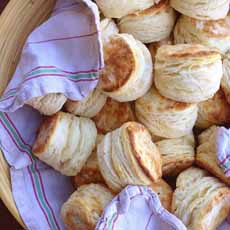Ham & Cheese Biscuits Recipe: Homemade Biscuits For Breakfast
|
We love to start the new year with homemade biscuits—a different type each year. This year, it’s ham and Gruyère, with fresh chives. The word biscuit dates to ancient Latin: bis cotus, meaning twice baked. These words form the origin of biscotti: initially a hard food with a long shelf life that could be taken on the road, in an era where roadside food was minimal at best. They were (and are) first baked, then dried out in a slow oven. It’s important to note that, like those hard Roman biscotti, the term biscuit in Europe still refers to what is called a cookie or cracker in the U.S. Scones, an early quick bread, are first mentioned in the early 16th century. (What’s a quickbread? See the footnote* below.) Spice buns appeared during the Tudor period (1485 to 1603). But it wasn’t until the 18th century that chemical leavenings (raising agents) enabled the moist, fluffy biscuits we know today. The leavening creates gas bubbles that lighten and soften the dough. Pearl ash (potash) was an early example; others included beer and kefir (both of which have live yeast), sour milk, vinegar, lemon juice, and or cream of tartar. Steam and air were used to raise popovers and Yorkshire pudding. Baking soda was used by the turn of the 19th century; baking powder was introduced in 1843 (the difference between baking powder and baking soda). And with them came light, fluffy breads and cakes galore. Biscuits and rolls are both made from flour, fat† (butter, shortening, olive oil), liquid (buttermilk, cream, milk, water), and salt. What’s the difference? Biscuits are raised with chemical leavening (baking powder); rolls are raised with yeast. This recipe is from National Pork Board, “Pork: Be Inspired.” They can be served at any meal of the day, but we prefer their complex flavors with the simpler foods of breakfast, or with a light lunch of soup and salad. The recipe was originally made with smoked Gouda, but we prefer Gruyère. You can substitute any semihard cheese. You can also substitute other types of bacon for the standard American bacon strips; and substitute chives for the thyme. Don’t hesitate to make any recipe your own, by substituting favorite ingredients or experimenting with new ones. Prep time is 20 minutes; bake time is 20 minutes. > There are more biscuit recipes below. Ingredients For 12 Biscuits |
 [1] “Ham and cheese” biscuits. You can use your favorite types of ham and cheese (photo © National Pork Board).
|
|
|
Preparation 1. PREHEAT the oven to 450°F. Butter a large baking sheet, or coat it with nonstick spray. 2. WHISK together in a large bowl the flour, baking powder, sugar salt, and baking soda. Use a pastry cutter or fingertips to add the butter, working the mixture until it resembles a coarse meal. 3. STIR in the ham, cheese, and chives. Add the yogurt, stirring until just combined. Drop the dough onto the prepared baking sheet in 12 equal mounds, about 1 inch apart. Bake until golden brown, 18 to 20 minutes. While the biscuits bake… 4. MAKE the maple butter. In a medium bowl, combine the butter and maple syrup. Add salt to taste and transfer to a serving bowl. 5. SERVE the biscuits warm with the maple butter on the side. *A quick bread is any bread leavened with a chemical leavening agent rather than a biological one (such as yeast or sourdough starter). They are able to be prepared quickly compared to the time-consuming skilled labor and the climate control needed for traditional yeast breads. In addition to savory breads such as beer bread, biscuits, cornbread, muffins, pancakes, scones, and soda bread, quick breads include sweet items. These include many cakes, brownies, and cookies as well as banana bread, carrot bread, pumpkin bread, and zucchini bread. Here’s more about quickbread. †Some types of rolls do not contain fat. CHECK OUT WHAT’S HAPPENING ON OUR HOME PAGE, THENIBBLE.COM. |
||





